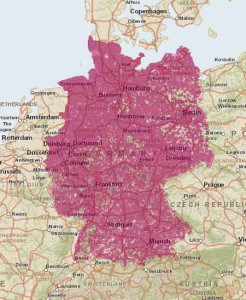According to the latest study of network coverage, this is the ranking of the German providers (sorted by reception quality):
This ranking is also reflecting the prices, with T-Mobile usually being the most expensive and Vodafone & O2 being more affordable.
Our recommendation
It is difficult to give a general recommendation on which carrier you should choose, because each region or even part of a city could have a different network coverage (see network coverage check below). In big cities you should have a good service with any German carrier. However, when you are traveling by bus or train, your carrier choice could make a big difference.
This is why we can recommend Deutsche Telekom’s young brand “congstar”: congstar uses the same network as T-Mobile, but is more affordable. Congstar’s Do It Yourself Prepaid offer lets you design your own plan according to your needs. In our opinion: A good deal. If you want to save some money on your mobile phone plan and the reception is not of big importance, you should choose the cheaper plans by O2 or third-party providers.
If you are just looking for a sim card that offer you as much high speed internet as possible, you should read our overview of the best data plans in Germany!
Check the individual network coverage

Before deciding on a network provider, you can check their network coverage by searching for your ZIP-code / city and address:
- Telekom (congstar) (check network coverage)
- Vodafone (check network coverage)
- O2 (check network coverage)
Generally speaking, there are two different types of networks in Germany: D-network (mostly used by T-Mobile and Vodafone) and E-network (mostly used by O2). In 2014, O2 (Telefónica) bought E-Plus, which means that both carriers use the same network now. The E-network is transmitting the signal on higher frequencies, which do not have a reach as high as the D-network’s. Additionally, the D-network operates more transmitting stations. These could be some of the reasons why O2 and E-Plus have a worse signal quality and a lower reach. It can also be said that the D-network gives you better reception inside of building than the E-network. Many third-party providers are still advertising their network being part of the D-network (“D-Netz Qualität”), as this is known to be more reliable.
If you need to contact customer service of either of the above providers, have a look at the different options to contact your provider.
Is my phone compatible with the German network?
Usually, most smartphones support various network frequencies and are compatible with the German network. However, if you are unsure, you could check your phone’s supported network frequency bands.
GSM (2G): Voice calls and text messages; some very slow data transmission as well.
UMTS (3G): Voice call and data transmission; speed up to 384 kbit/s.
2G and 3G are mostly not in use anymore in Germany. Most providers offer 4G and 5G:
LTE (4G): Voice call and data transmission; speed up to 1000 MBit/s.
LTE (5G): Voice call and data transmission; speed up to 10 GBit/s.
However, which speed you get is highly dependent on the provider, on the plan you selected and on your location/connection. Most plans don’t come close to the maximum speed of 4G or 5G so you need to compare which maximum speed your individual plan provides on paper. Most likely you will be able to get a speed between 50MBit/s and 100MBit/s. Here you will find an overview of different data plans in Germany
For GSM service in Germany, your phone needs to support the FDD frequency bands 3 (1800-MHz) and 8 (900-MHz).
For UMTS, Germany uses band 1 (2100-MHz) like most of the world (except USA).
For German LTE data service, your phone needs to support the LTE-FDD bands 1 (2100-MHz), 3 (1800-MHz), 7 (2600-MHz) and 20 (800-MHz). If some of the bands are not supported by your phone, your connection speed will probably not reach the usual LTE speed and will be limited.
For example, Vodafone and O2 use band 20 (800-MHz) in rural areas as well as cities.
Deutsche Telekom (Congstar) also uses band 20 (800-MHz) on the countryside, but mostly makes use of band 3 (1800-MHz) in cities. Deutsche Telekom (Congstar) also started using band 8 (900-MHz) for LTE, while Vodafone and O2 still use that frequency band for GSM.
As always, if you have any questions, just write us an email: support@mygermanphone.de or contact us via Facebook Messenger for immediate responses.


Congstar Fair Flat in the best mobile network
[…] Which Carrier? […]
Ed Parker
Hi – my daughter will be working in Germany for 10 weeks this Summer. We’ve heard that o2 has great service.
She currently has AT&T for her iphone. Is there a way for her to connect to the o2 network (for data) just for the Summer – without permanently making changes to her AT&T Plan? Can she buy a mobile hotspot to connect? Any chance you could email me instructions in English? Thank you very much for your help.
MyGermanPhone
Hi Ed, we would actually recommend to use Congstar during her time in Germany with her iPhone. Congstar normally has a better service and you can simply use an eSIM, which you can add to your iPhone in addition to your existing SIM card from AT&T.
Bright Fahnlon Sackie
I am looking for an affordable prepaid montly sim card with good connection and speed.
Klarmobil: Allnet Flat plans with great value | My German Phone
[…] Which Carrier? […]